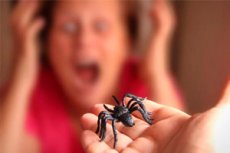New publications
Fear of spiders and fear of heights are related
Last reviewed: 29.06.2025

All iLive content is medically reviewed or fact checked to ensure as much factual accuracy as possible.
We have strict sourcing guidelines and only link to reputable media sites, academic research institutions and, whenever possible, medically peer reviewed studies. Note that the numbers in parentheses ([1], [2], etc.) are clickable links to these studies.
If you feel that any of our content is inaccurate, out-of-date, or otherwise questionable, please select it and press Ctrl + Enter.

If you get rid of arachnophobia, you can also deal with the fear of heights at the same time.
Phobic conditions are pathologies characterized by anxiety attacks, obsessive fears, manifested by trembling, increased sweating, impaired consciousness, etc. The strongest and sometimes unexplained feeling of panic is caused by a particular stimulus.
The most common way to eliminate any existing fear is to apply exposure, that is, to face the object of your fear directly in a safe environment. It is not a matter of picking up a spider and holding it in spite of the fear. The impact on phobia begins with the demonstration of photos, imaginary representation of phobic objects. At the same time should be active work psychologist, whose goal - to understand why the patient feels fear, what exactly causes negative emotions, etc. Patient and gradual work leads to the fact that the fear is leveled.
It is known that a person often experiences several phobias at the same time. It is logical that they should be treated separately from each other. For example, when a patient complains that he is immensely afraid of spiders and heights, then the treatment should be carried out in turn, separately affecting arachnophobia, and then - on fear of heights, or vice versa. However, representatives of the Ruhr University have shown that these two fears can and should be treated together.
Researchers selected 50 people with both arachnophobia and acrophobia (fear of heights). The treatment was directed only at the fear of spiders. In the course of therapy they checked the degree of phobia, conducted various tests and surveys. Notably, the patients themselves indicated that both problems gradually receded. This was confirmed by the tests conducted.
The promise of this research is impressive. However, not everything is so simple: it is important for experts to understand the causes and mechanism of this influence, as well as to compare the possible impact on other pathological fears. It is difficult to trace what spiders and heights have in common. It is possible that similar links can be formed between other phobias.
Scientists will have to do a lot of work, analyze all the involved mental processes to enhance the effect of anti-phobic therapy. It is known that in practice it is difficult to get rid of fears completely: in most cases it is possible only to reduce their manifestations. In this regard, scientists still have a lot of work to do, because there are many phobic disorders of all kinds, fear and panic people can experience almost any objects and phenomena that not only exist in life, but also arise in the imagination.
Treatment can be made more effective. It is equally important to seek help from psychotherapists in a timely manner and not to be ashamed of your feelings.
The full article is available at in Translational Psychiatry
